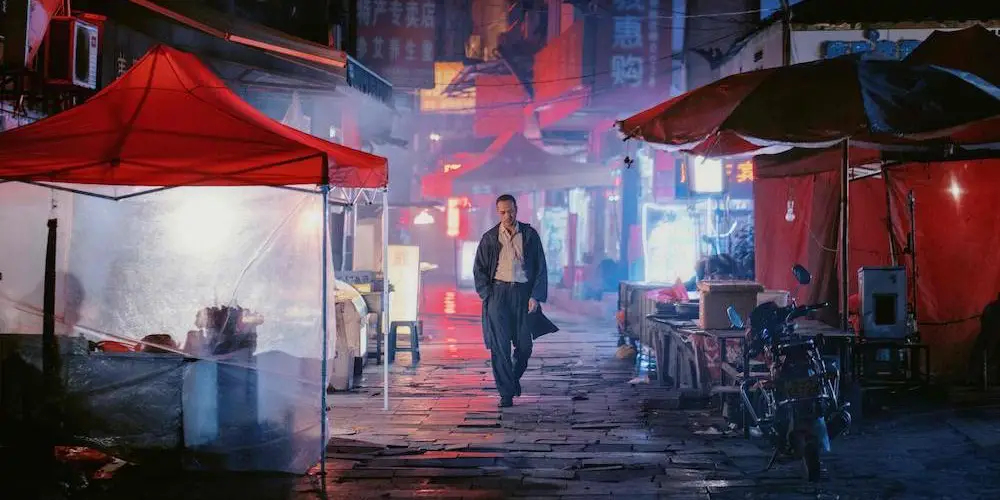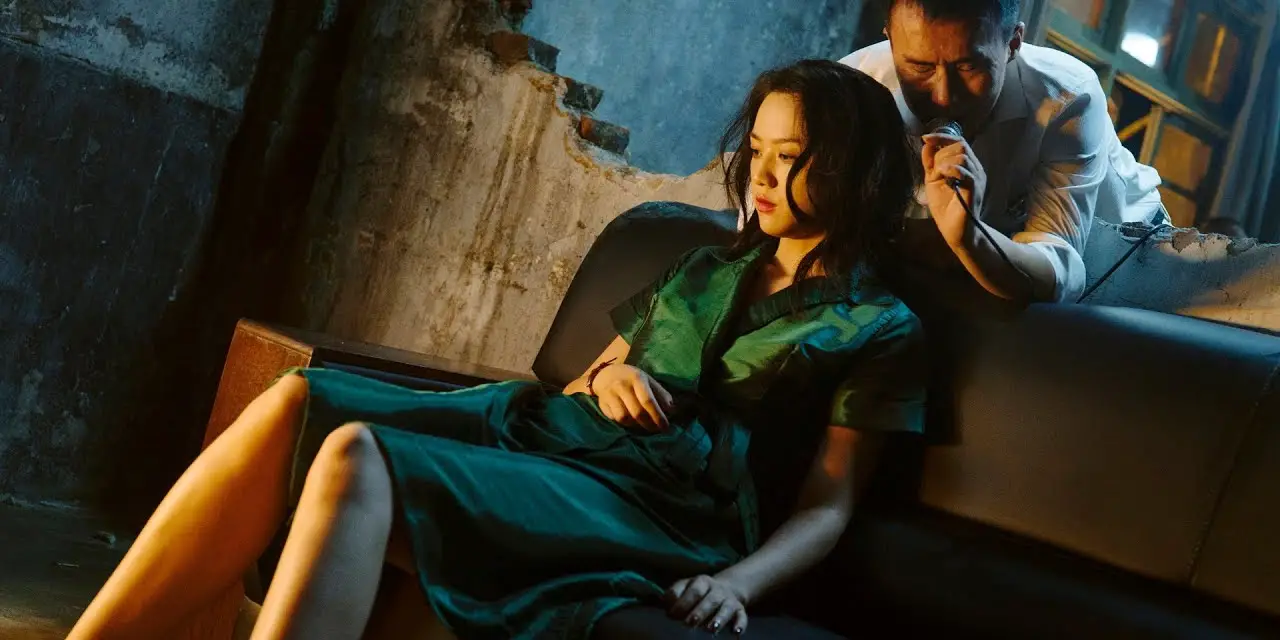LONG DAY’S JOURNEY INTO NIGHT: The New Era Of 3-D

Alex Lei is a writer and filmmaker with a BA…
“It’ll be obvious when to put them on,” the ticket taker said, handing me and my friend our glasses. It wasn’t unlike going to see Spy Kids 3D with my mom way-back-when, although this time it was a Chinese arthouse blockbuster instead of a Robert Rodriguez romp. The only thing more surreal than the experience of going to see Bi Gan’s Long Day’s Journey Into Night is perhaps the movie itself.
The story of the film is simple enough, if only in a Resnaisian sense — Luo Hongwu (Huang Jue) is a man wandering through a noir-ish Kaili, crossing and recrossing through disjointed time with a long-lost love Kaizhen (Tang Wei), or perhaps she’s the movie star Wan Qiwen, he doesn’t seem to know.
A Dream Within a Dream
It is not until almost 90 minutes into the film that we get our fateful 3-D, hour-long oner. Luo is on the verge of maybe finally finding Kaizhen, maybe finally getting answers, and is told to wait at a movie theater. He sits down, and sees those around him are putting on their 3-D glasses — me and my friend look at each other and laugh a little, we know what to do. The title card nearly pops out of the screen: “Long Day’s Journey Into Night.” And so the movie within the movie begins.

I’ve sometimes heard movies described as a dream within a dream, and by extension of that, Long Day’s adds another layer. The film’s enigmatic storytelling and disjointed timeline, in a way, resolve themselves in this hour-long take. It’s not unlike the final act of David Lynch‘s Mulholland Drive, where all the characters we’ve seen before and now presented more clearly through a new nightmare, one that is probably the real events that have been run through the dream logic of the first 100 minutes. Long Day’s inverts this, showing life and memory as the most enigmatic, and the dream (or cinema, or storytelling), while surreal and impossible, is a way to resolve what we’ve seen but don’t understand.
But Bi‘s film goes another step beyond just dream logic, by presenting a certain dream experience through the 3-D. The illusion of a “third dimension” to cinema is a trick done in post for Bi‘s film, but from a theoretical standpoint it gets more complicated. Eisenstein referred to sound as being a fourth dimension to film, one that if removed would create a fundamentally different experience to the film. By this logic, viewing Bi‘s film not in standard 2-D would lose something essential to its experience. Not only does the 3-D of the film function to separate the movie within a movie, but brings the viewer in closer as an observer within the space of the film as opposed to outside it. Moreover, the 3-D and the take are both intended to very literally take the viewer on a ride, and arguably neglecting one element of that would further distance the viewer.
3-D in the Time of Streaming
I was fortunate enough to be in a big city that had many arthouse theaters when I saw Long Day’s Journey Into Night so I could see it in 3-D as originally intended. Five years ago when I was in college, there was nowhere within 600 miles that was playing Jean-Luc Godard‘s Goodbye to Language 3D. Although I saw it on Netflix a year later and could see the moments where the 3-D would physically severe apart, one image briefly pulling itself into two, I could understand what was happening but could not be a part of it. It’s interesting to me that along with the increase in accessibility to these arthouse films through streaming, filmmakers have strove to create their movies around more exclusionary experiences to get their full effect — whether that be the 70mm roadshow of The Hateful Eight or avant-garde experiments like Long Day’s and Goodbye to Language. On that Tarantino end of the spectrum, it almost always feels like a ploy to get audiences to enjoy the movies the exact way the filmmaker wants them to be enjoyed.

But Long Day’s Journey Into Night is perhaps the most interesting case-study into this, and even a deconstruction of film advertising and exhibition. In China, the film famously branded itself as a romantic epic, perfect for couples on the Chinese New Years, even ending with a kiss timed exactly at midnight so the lovers in the theater could follow suit. However, as is probably obvious, the people who went to see it on this notion were sorely confused and frustrated by the film itself, and $38 million of its $41 million Chinese box office returns came in that first weekend of its release. What was branded as a 3-D event in one country got rebranded as an arthouse curiosity in others — both intentional by the filmmaker. On one hand we have an impenetrable movie sold to an audience that wouldn’t want it, and on the other we have a product that sought after by a niche that has little access to see it as intended.
Long Day’s Journey Into Night: Conclusion
I’m glad that Long Day’s Journey Into Night exists as a the kind of movie that intentionally tries to get audiences to watch it in theaters through something more than just a gimmick, but it also points out a problem area we’re at with film distribution. On one hand, it serves and an excellent and unique experience for those who have access to it, and on the other, further exacerbates very real problems that lead to an exclusionary film culture. Long Day’s is a rare example, especially for arthouse, where this conflict is discussed much more through how the movie was marketed than the text of the film itself.
Have you seen Long Day’s Journey Into Night? Did you get to see in 2D or 3D, and how did that effect your viewing experience? Let us know in the comments below!
Long Day’s Journey Into Night was released in the US on April 12, 2019. For all international release dates, see here.
Does content like this matter to you?
Become a Member and support film journalism. Unlock access to all of Film Inquiry`s great articles. Join a community of like-minded readers who are passionate about cinema - get access to our private members Network, give back to independent filmmakers, and more.
Alex Lei is a writer and filmmaker with a BA in Film with a minor in Philosophy from Montana State University, focusing his thesis on post-Stalinist Soviet filmmaking. Currently based in Baltimore, MD, he's a fan of Russia, cowboys, and sometimes Russian cowboys.













